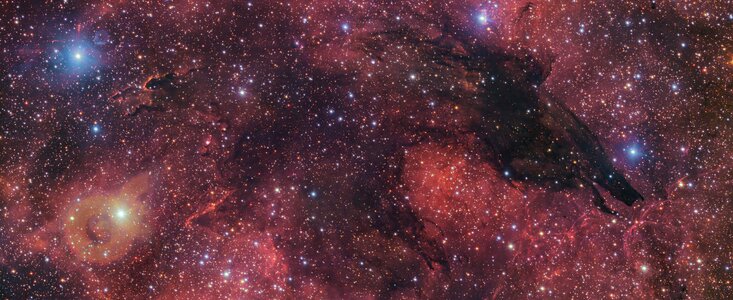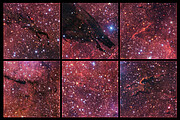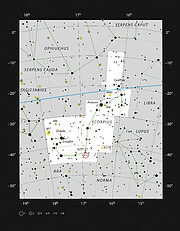Nota de prensa
Una nueva imagen de ESO capta a un lobo oscuro en el cielo
31 de Octubre de 2024
Por Halloween, el Observatorio Europeo Austral (ESO) revela esta espeluznante imagen de una nebulosa oscura que crea la ilusión de una silueta similar a la de un lobo sobre un colorido telón de fondo cósmico. Apodada la Nebulosa del Lobo Oscuro, fue captada en una imagen de 283 millones de píxeles por el VLT Survey Telescope (VST), instalado en el Observatorio Paranal de ESO, en Chile.
Encontrada en la constelación de Escorpio, cerca del centro de la Vía Láctea en el cielo, la Nebulosa del Lobo Oscuro se encuentra a unos 5300 años luz de la Tierra. Esta imagen ocupa un área en el cielo equivalente a cuatro lunas llenas, pero en realidad es parte de una nebulosa aún más grande llamada Gum 55. Si se fijan bien, el lobo podría ser incluso un hombre lobo, con las manos listas para agarrar a los transeúntes desprevenidos...
Si pensaban que la oscuridad es igual al vacío, piénsenlo de nuevo. Las nebulosas oscuras son nubes frías de polvo cósmico, tan densas que oscurecen la luz de las estrellas y otros objetos que se encuentran detrás de ellas. Como su nombre indica, a diferencia de otras nebulosas, no emiten luz visible. Los granos de polvo que hay en su interior absorben la luz visible y solo dejan pasar la radiación en longitudes de onda más largas, como la luz infrarroja. La comunidad astronómica estudia estas nubes de polvo congelado porque a menudo contienen nuevas estrellas en formación.
Por supuesto, rastrear la presencia fantasmal del lobo en el cielo solo es posible porque contrasta con un fondo brillante. Esta imagen muestra con espectacular detalle cómo el lobo oscuro destaca contra las brillantes nubes de formación estelar que hay detrás de él. Las coloridas nubes están formadas principalmente por gas de hidrógeno y brillan en tonos rojizos, excitado por la intensa radiación UV de las estrellas recién nacidas que hay en su interior.
Algunas nebulosas oscuras, como la Nebulosa del Saco de Carbón, se pueden ver a simple vista (y juegan un papel clave en la forma en que los primeros pueblos nativos interpretaron el cielo [1]) pero no es el caso del Lobo Oscuro. Esta imagen fue creada utilizando datos del VLT Survey Telescope, propiedad del Instituto Nacional de Astrofísica de Italia (INAF) e instalado en el Observatorio Paranal de ESO, en el desierto de Atacama, en Chile. El telescopio está equipado con una cámara especialmente diseñada para cartografiar el cielo del sur en luz visible.
La imagen se compiló a partir de imágenes tomadas en diferentes momentos, cada una con un filtro que deja entrar un color de luz diferente. Todas fueron captadas durante el sondeo VPHAS+ (VST Photometric Hα Survey of the Southern Galactic Plane and Bulge, sondeo fotométrico en Hα del plano y bulbo galácticos del cielo austral con el VST), que ha estudiado unos 500 millones de objetos en nuestra Vía Láctea. Sondeos como este ayudan a la comunidad científica a comprender mejor el ciclo de vida de las estrellas dentro de nuestra galaxia, y los datos obtenidos se hace públicos a través del portal científico de ESO. Exploren este tesoro de datos ustedes mismos: ¿quién sabe qué otras formas espeluznantes descubrirán en la oscuridad?
Notas
[1] Los mapuches del centro-sur de Chile se refieren a la Nebulosa del Saco de Carbón como 'pozoko' (pozo de agua), y los incas la llamaron 'yutu' (un ave parecida a una perdiz).
Información adicional
El Observatorio Europeo Austral (ESO) pone a disposición de la comunidad científica mundial los medios necesarios para desvelar los secretos del Universo en beneficio de todos. Diseñamos, construimos y operamos observatorios de vanguardia basados en tierra -utilizados por la comunidad astronómica para abordar preguntas emocionantes y difundir la fascinación por la astronomía- y promovemos la colaboración internacional en astronomía. Establecida como organización intergubernamental en 1962, hoy ESO cuenta con el apoyo de 16 Estados Miembros (Alemania, Austria, Bélgica, Dinamarca, España, Finlandia, Francia, Irlanda, Italia, Países Bajos, Polonia, Portugal, Reino Unido, República Checa, Suecia y Suiza), junto con Chile, país anfitrión, y con Australia como socio estratégico. La sede de ESO y su planetario y centro de visitantes, el ESO Supernova, se encuentran cerca de Múnich (Alemania), mientras que el desierto chileno de Atacama, un lugar maravilloso con condiciones únicas para observar el cielo, alberga nuestros telescopios. ESO opera tres sitios de observación: La Silla, Paranal y Chajnantor. En Paranal, ESO opera el Very Large Telescope junto con su interferómetro VLTI (Very Large Telescope Interferometer), y telescopios de rastreo como VISTA. También en Paranal, ESO albergará y operará el Cherenkov Telescope Array South, el observatorio de rayos gamma más grande y sensible del mundo. En Chajnantor, junto con socios internacionales, ESO opera ALMA, una instalación que observa los cielos en el rango milimétrico y submilimétrico. En Cerro Armazones, cerca de Paranal, estamos construyendo "el ojo más grande del mundo para mirar el cielo": el Telescopio Extremadamente Grande de ESO (ELT, Extremely Large Telescope). Desde nuestras oficinas en Santiago (Chile), apoyamos el desarrollo de nuestras operaciones en el país y nos comprometemos con los socios chilenos y con la sociedad chilena.
Las traducciones de las notas de prensa de ESO las llevan a cabo miembros de la Red de Divulgación de la Ciencia de ESO (ESON por sus siglas en inglés), que incluye a expertos en divulgación y comunicadores científicos de todos los países miembros de ESO y de otras naciones.
El nodo español de la red ESON está representado por J. Miguel Mas Hesse y Natalia Ruiz Zelmanovitch.
Enlaces
- Fotos de los telescopios de rastreo en Paranal, incluyendo el VST
- Para periodistas: suscríbete para recibir nuestros comunicados embargados y en tu idioma
- Para científicos/as: ¿tienes una historia? Presenta tu investigación
Contactos
Juan Carlos Muñoz Mateos
ESO Media Officer
Garching bei München, Germany
Teléfono: +49 89 3200 6176
Correo electrónico: jmunoz@eso.org
Bárbara Ferreira
ESO Media Manager
Garching bei München, Germany
Teléfono: +49 89 3200 6670
Celular: +49 151 241 664 00
Correo electrónico: press@eso.org
Francisco Rodríguez (Contacto para medios de comunicación en Chile)
Red de Difusión Científica de ESO
y European Southern Observatory
Teléfono: +56-2-463-3151
Correo electrónico: eson-chile@eso.org
Acerca de la nota de prensa
| Nota de prensa No.: | eso2416es-cl |
| Nombre: | Dark Wolf Nebula |
| Tipo: | Milky Way : Nebula : Type : Star Formation |
| Facility: | VLT Survey Telescope |
Our use of Cookies
We use cookies that are essential for accessing our websites and using our services. We also use cookies to analyse, measure and improve our websites’ performance, to enable content sharing via social media and to display media content hosted on third-party platforms.
ESO Cookies Policy
The European Organisation for Astronomical Research in the Southern Hemisphere (ESO) is the pre-eminent intergovernmental science and technology organisation in astronomy. It carries out an ambitious programme focused on the design, construction and operation of powerful ground-based observing facilities for astronomy.
This Cookies Policy is intended to provide clarity by outlining the cookies used on the ESO public websites, their functions, the options you have for controlling them, and the ways you can contact us for additional details.
What are cookies?
Cookies are small pieces of data stored on your device by websites you visit. They serve various purposes, such as remembering login credentials and preferences and enhance your browsing experience.
Categories of cookies we use
Essential cookies (always active): These cookies are strictly necessary for the proper functioning of our website. Without these cookies, the website cannot operate correctly, and certain services, such as logging in or accessing secure areas, may not be available; because they are essential for the website’s operation, they cannot be disabled.
Functional Cookies: These cookies enhance your browsing experience by enabling additional features and personalization, such as remembering your preferences and settings. While not strictly necessary for the website to function, they improve usability and convenience; these cookies are only placed if you provide your consent.
Analytics cookies: These cookies collect information about how visitors interact with our website, such as which pages are visited most often and how users navigate the site. This data helps us improve website performance, optimize content, and enhance the user experience; these cookies are only placed if you provide your consent. We use the following analytics cookies.
Matomo Cookies:
This website uses Matomo (formerly Piwik), an open source software which enables the statistical analysis of website visits. Matomo uses cookies (text files) which are saved on your computer and which allow us to analyze how you use our website. The website user information generated by the cookies will only be saved on the servers of our IT Department. We use this information to analyze www.eso.org visits and to prepare reports on website activities. These data will not be disclosed to third parties.
On behalf of ESO, Matomo will use this information for the purpose of evaluating your use of the website, compiling reports on website activity and providing other services relating to website activity and internet usage.
Matomo cookies settings:
Additional Third-party cookies on ESO websites: some of our pages display content from external providers, e.g. YouTube.
Such third-party services are outside of ESO control and may, at any time, change their terms of service, use of cookies, etc.
YouTube: Some videos on the ESO website are embedded from ESO’s official YouTube channel. We have enabled YouTube’s privacy-enhanced mode, meaning that no cookies are set unless the user actively clicks on the video to play it. Additionally, in this mode, YouTube does not store any personally identifiable cookie data for embedded video playbacks. For more details, please refer to YouTube’s embedding videos information page.
Cookies can also be classified based on the following elements.
Regarding the domain, there are:
- First-party cookies, set by the website you are currently visiting. They are stored by the same domain that you are browsing and are used to enhance your experience on that site;
- Third-party cookies, set by a domain other than the one you are currently visiting.
As for their duration, cookies can be:
- Browser-session cookies, which are deleted when the user closes the browser;
- Stored cookies, which stay on the user's device for a predetermined period of time.
How to manage cookies
Cookie settings: You can modify your cookie choices for the ESO webpages at any time by clicking on the link Cookie settings at the bottom of any page.
In your browser: If you wish to delete cookies or instruct your browser to delete or block cookies by default, please visit the help pages of your browser:
Please be aware that if you delete or decline cookies, certain functionalities of our website may be not be available and your browsing experience may be affected.
You can set most browsers to prevent any cookies being placed on your device, but you may then have to manually adjust some preferences every time you visit a site/page. And some services and functionalities may not work properly at all (e.g. profile logging-in, shop check out).
Updates to the ESO Cookies Policy
The ESO Cookies Policy may be subject to future updates, which will be made available on this page.
Additional information
For any queries related to cookies, please contact: pdprATesoDOTorg.
As ESO public webpages are managed by our Department of Communication, your questions will be dealt with the support of the said Department.




